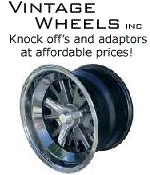Welcome to Club Cobra! The World's largest
non biased Shelby Cobra related site!
- » Representation from nearly all
Cobra/Daytona/GT40 manufacturers
- » Help from all over the world for your
questions
- » Build logs for you and all members
- » Blogs
- » Image Gallery
- » Many thousands of members and nearly 1
million posts!
YES! I want to register an account for free right now!
p.s.: For registered members this ad will NOT show
 
 Main Menu
Main Menu
|
 Nevada Classics
Nevada Classics
|
 Advertise at CC
Advertise at CC
|
 January 2025
January 2025
|
| S |
M |
T |
W |
T |
F |
S |
| |
|
|
1 |
2 |
3 |
4 |
| 5 |
6 |
7 |
8 |
9 |
10 |
11 |
| 12 |
13 |
14 |
15 |
16 |
17 |
18 |
| 19 |
20 |
21 |
22 |
23 |
24 |
25 |
| 26 |
27 |
28 |
29 |
30 |
31 |
|
|
 CC Advertisers
CC Advertisers
|
|
 1Likes 1Likes

06-03-2009, 04:54 AM
|
 |
CC Member

|
|
|
Join Date: Jul 2004
Cobra Make, Engine: 347 Stroker Morrison Injection. Registered.
Posts: 1,440
|
|

 Not Ranked
Not Ranked
 Master Cylinder Sizes
Master Cylinder Sizes
Would I have any problem using the same size master cylinders for the front and rear on my Classic Revival? Ive got Wilwood 4 spotters on the front and Ford XR8 2 spotters on the rear. My master cylinders are 3/4 for both.
Regards.
__________________
Mando
|
-
Advertising


06-03-2009, 05:46 AM
|
 |
CC Member

|
|
|
Join Date: Dec 2000
Location: Broken Arrow. OK ( South Tulsa), USA,
OK
Cobra Make, Engine: 66 COBRA FE 427 /4SP. (HCS Coupe w/ 408 Stroker and TKO 600 -sold)
Posts: 5,595
|
|

 Not Ranked
Not Ranked
I have had that set up before but I prefer the 7/8" in the front and 3/4" in the rear. Street driving may be just fine but on the track I could really tell the difference.
Clois
__________________
Sunshine, Asphalt and no stop signs...Perfect
"Let's roll"
"Be part of Something Good
......Leave Something Good Behind!"
from CD "Long Road Out of Eden"
|

06-03-2009, 07:14 AM
|
 |
Member of the north

|
|
|
Join Date: May 2003
Cobra Make, Engine: A Cobra
Posts: 11,207
|
|

 Not Ranked
Not Ranked
If you know the volume of the caliper, you can do the math to see the difference in pressure.
Or, you can leave the caliper as X and see the diffence the different masters make. I think in Clois' case, he has the fronts before the rears on pressure.
  |

06-03-2009, 07:27 AM
|
 |
CC Member

|
|
|
Join Date: Dec 2000
Location: Broken Arrow. OK ( South Tulsa), USA,
OK
Cobra Make, Engine: 66 COBRA FE 427 /4SP. (HCS Coupe w/ 408 Stroker and TKO 600 -sold)
Posts: 5,595
|
|

 Not Ranked
Not Ranked
Yep, Sure do. And I have a proportioning valve within arms reach from my drivers seat for some fine tuning.
__________________
Sunshine, Asphalt and no stop signs...Perfect
"Let's roll"
"Be part of Something Good
......Leave Something Good Behind!"
from CD "Long Road Out of Eden"
|

06-03-2009, 11:55 AM
|
|
CC Member

|
|
|
Join Date: May 2007
Cobra Make, Engine: JCF supplied the body,frame,and some of the driveline-I completed it to be a very accurate 289 slabside
Posts: 149
|
|

 Not Ranked
Not Ranked
I don't know what Trularin means about the caliper volume affecting pressure. The master cylinder diameter determines brake line pressure and therefore braking force. A smaller diameter gives a higher pressure.
|

06-03-2009, 08:20 PM
|
 |
CC Member

|
|
|
Join Date: Jan 2001
Location: Sunbury,
VIC
Cobra Make, Engine: Rat Rod Racer, LS1 & T56
Posts: 5,391
|
|

 Not Ranked
Not Ranked
You've also got to take into account pedal ratio for your calculations. In my opinion I don't think our pedal ratio is as high enough in the CR pedal box.
3/4" front and 5/8" rear is the go Mando.
I think I have a spare 5/8" willwood cylinder if you need one.
Cheers
__________________
Mike Murphy
Melbourne Australia
Last edited by Aussie Mike; 06-03-2009 at 08:23 PM..
|

06-03-2009, 09:37 PM
|
 |
CC Member

|
|
|
Join Date: Jul 2004
Cobra Make, Engine: 347 Stroker Morrison Injection. Registered.
Posts: 1,440
|
|

 Not Ranked
Not Ranked
Hi Mike, what would be the likely result of using 3/4" for both? If its a problem would installing a proportioning valve on the rear brakes only fix the problem?
Regards.
__________________
Mando
|

06-04-2009, 12:01 AM
|
 |
CC Member

|
|
|
Join Date: Jun 2007
Location: Sunshine Coast Qld,
QLD
Cobra Make, Engine: Harrison # 80; Ford 5.0L HO Trickflow heads, cam and rockers and MassFlow EFI
Posts: 3,482
|
|

 Not Ranked
Not Ranked
Nice car Jon! You guys in the US really seem to take the 'replica' very seriously and do it well. (sorry to distract the thread).
Merv
__________________
Merv
Ford Cobra
Harrison #80.
Peregian Beach
Sunshine Coast Qld.
|

06-04-2009, 12:36 AM
|
 |
CC Member

|
|
|
Join Date: Jan 2001
Location: Sunbury,
VIC
Cobra Make, Engine: Rat Rod Racer, LS1 & T56
Posts: 5,391
|
|

 Not Ranked
Not Ranked

Hydraulics is all about leverage. The difference in sizes between the size of the master cylinder bore and the caliper piston bore will give you an increase in leverage.
Here's a rough example:
You apply 100 pounds of force to your brake pedal. There is a 6:1 ratio in your pedal so that equals 600 pounds of force against the master cylinder.
The master cylinder bore is 3/4" which if you work out the piston area is 0.4418 square inches.
Pi x Radius squared: 3.14159 x (0.375x0.375) =0.4418
We want to work out the pressure in square inches so we divide 600 pounds by the area we are pushing against (0.4418 square inches) and we get 1358 Pounds per square inch. This is our line pressure.
We then feed that down a steel brake line to the caliper where it has a piston 1.5" in diameter. This has a surface area of 1.7671 square inches. We are applying 1358 pounds per square inch of pressure so we multiply that by the number of square inches of piston and that gives us 2400 pounds of clamping force.
So with these calculations we can work out how much clamping force we generate for the front and rear brakes.
When working out the clamping force you find opposed pistons cancel each other out. If you have a pair of 1.5" pistons working against each other for the calculated area you use only one piston.
So the rear has a single piston caliper and for the front example we'll assume 4 piston calipers with 1.25" pistons (2.454" square).
With a 3/4" master and our 1358 PSI of line pressure that equates to 3332 pounds of clamping force on our front brakes.
The front and the rear of the car require different amounts of braking force to stay in balance. By that I mean we want the front and rear tyres to lock up about the same time or preferably the fronts before the rears.
There are a bunch of different factors that come into play here, the main one being weight transfer. The weight of the vehicle moves to the front of the car as it decelerates forcing the front tyres onto the road and making them grip better. The front to rear weight bias of the car, and suspension setup are a factors that control weight transfer.
The diameter of the brake rotors affects how much leverage the calaper has on the disc. A larger diameter disc has more leverage than a smaller disc and requires less clamping force. The friction coeficient of the pad material comes into effect too. some pads are grippier than others. The tyres and their level of grip is a factor
So what we have with our Cobra is a car with a rearward weight bias and low center of gravity. Add that to firm suspension and you have a car that won't transfer nearly as much weight as say your average Ford Falcon. This means a Cobra can use more rear brake and less front brake in comparison with that family sedan.
What the net result of having the same size master cylinders front and rear is that we may not get the right bias between front and rear braking forces. You may end up with your balance bar wound right accross to one side. You dont have enough adjustment to get the bias right where fronts and rears are close to locking at the same time. The balance bar should really a tuning aid and you need the system balance to be pretty close in the first place.
dropping the rear master cylinder size to 5/8" gives us 0.3067 square inches. This makes 1956 PSI of line pressure for the same pedal force.
If you already have 2x 3/4" master cylinders give them a try, they may work OK. If you find you need more rear bias you can switch to the smaller rear cylinder.
A proportioning valve will only take pressure out of the rear circuit. I don't think it's legal to run one in the front circuit.
Hope this helps.
Cheers
__________________
Mike Murphy
Melbourne Australia
Last edited by Aussie Mike; 06-04-2009 at 06:36 PM..
Reason: correcting terms
|

06-04-2009, 12:54 AM
|
 |
CC Member

|
|
|
Join Date: Feb 2007
Location: Toowoomba,,
QLD
Cobra Make, Engine: Harrison supercharged
Posts: 291
|
|

 Not Ranked
Not Ranked
 Great work Mike you really know your stuff 
__________________
Harrison Cobra
Ford 4.6l supercharged
T56 six speed
|

06-04-2009, 01:19 AM
|
 |
CC Member

|
|
|
Join Date: Jan 2001
Location: Sunbury,
VIC
Cobra Make, Engine: Rat Rod Racer, LS1 & T56
Posts: 5,391
|
|

 Not Ranked
Not Ranked
Quote:
Originally Posted by hsv300

 Great work Mike you really know your stuff  |
Thanks Greg,
The theory is pretty simple once you get your head round it. The trick is getting it to work in the real world. Understanding the theory a little at lest makes it easy to understand what's happening when you make changes.
Cheers
__________________
Mike Murphy
Melbourne Australia
|

06-04-2009, 04:34 AM
|
 |
CC Member

|
|
|
Join Date: Jul 2004
Cobra Make, Engine: 347 Stroker Morrison Injection. Registered.
Posts: 1,440
|
|

 Not Ranked
Not Ranked
Thanks for the explanation Mike and thanks for the offer of the master cylinder, things seem a lot clearer now. I had a 5/8" cylinder but used on the clutch by mistake. If I hadnt cut the shaft down Id swap them over.
Regards.
__________________
Mando
|

06-04-2009, 05:05 AM
|
 |
CC Member

|
|
|
Join Date: Aug 2001
Location: Melbourne, Australia,
Vic
Cobra Make, Engine: G-Force Mk I, 5L Windsor, TKO 600, enhanced Jag / Koni suspension & LSD Diff.
Posts: 2,303
|
|

 Not Ranked
Not Ranked
why is it so Professor Mike???
__________________
slowy
|

06-04-2009, 06:24 AM
|
 |
CC Member

|
|
|
Join Date: Jan 2001
Location: Sunbury,
VIC
Cobra Make, Engine: Rat Rod Racer, LS1 & T56
Posts: 5,391
|
|

 Not Ranked
Not Ranked
Quote:
Originally Posted by Mando

Thanks for the explanation Mike and thanks for the offer of the master cylinder, things seem a lot clearer now. I had a 5/8" cylinder but used on the clutch by mistake. If I hadnt cut the shaft down Id swap them over.
Regards.
|
You can swap the shafts over pretty easy. Pop the rubber boot off the back and pop out the circlip in there. The shaft will come right out as it's usually held in by a washer under the circlip.
The end of the shaft is located by the same circlip that keeps the piston in place and this can be under spring pressure. Probably best to do it on the bench so it doesn't pop appart and leak brake fluid on your paint.
Cheers
__________________
Mike Murphy
Melbourne Australia
|

06-04-2009, 06:32 AM
|
 |
CC Member

|
|
|
Join Date: Apr 2008
Location: Melbourne,
VIC
Cobra Make, Engine: Classic Revival CR 3505, LS1, T56 6 Speed, VE 3.45 LSD Rear, 6 Spot AP Fronts, 4 Spot Wilwood Rears
Posts: 1,121
|
|

 Not Ranked
Not Ranked

Quote:
Originally Posted by Aussie Mike

So what we have with our Cobra is a car with a rearward weight bias and low center of gravity. Add that to firm suspension and you have a car that won't transfer nearly as much weight as say your average ford falcon. This means a Cobra can use more rear brake and less front brake in comparison with that family sedan.
What the net result of having the same size master cylinders front and rear is that we may not bet the right bias between front and rear braking forces. You may end up with your balance bar wound right accross to one side and have enough adjustment to get the bias right where fronts and rears are close to locking at the same time.
|
Hey Mike, I've got dual 3/4" in my CR and have to have my brake balance bar wound all the way to the left (front) to get what I believe is a front bias. Although I think my problem is that the Front Discs are std VZ and the rear Std VE. I think maybe if I had higher performance fronts I might get a better balance gived the weight transfer dynamic you mentioned in the Cobras.
What do you reckon professor Mike? 

|

06-04-2009, 07:18 AM
|
 |
CC Member

|
|
|
Join Date: Aug 2001
Location: Melbourne, Australia,
Vic
Cobra Make, Engine: G-Force Mk I, 5L Windsor, TKO 600, enhanced Jag / Koni suspension & LSD Diff.
Posts: 2,303
|
|

 Not Ranked
Not Ranked
Now if Mike had only posted that explanation on Tuesday night Gregg, you could have button holed him over a beer last night for an in-depth discussion.
And Mike how does the operation of the crack valve in the master come into play in all this as one steps on the brake pedal?
I ask as per Bernie's suggestion during my engineering brake test and under the guidance of my brake specialist I had one alternate crack valve option available to me to try and lessen the front bias break load. Yet to see what results this achieves.
Cheers
__________________
slowy
|

06-04-2009, 09:35 AM
|
 |
CC Member

|
|
|
Join Date: Jan 2001
Location: Sunbury,
VIC
Cobra Make, Engine: Rat Rod Racer, LS1 & T56
Posts: 5,391
|
|

 Not Ranked
Not Ranked

Hi Slowy,
My understanding of how a proportioning valve or a crack valve works is it's just a spring loaded piston in the circuit. The tension of the spring provides the crack point or the point at which the pressure between front and rear circuits will change.
For example if the proportioning valve has a 600 pound sq in spring pressure then the pressure in both the front and rear circuits will be the same till they reach 600PSI. At this point the line pressure overcomes the spring pressure in the proportioning valve and starts pushing the piston back. Suddenly your line pressure is split between applying pressure to the caliper and pressure against the spring loaded piston. That 600 PSI or what ever pressure it kicks in at is called the crack point or knee.
You can do the same math to work out what tension the spring would need depending on the size of the piston used just like with the master cylinders.
So what we know about springs is that most of them are fairly linear and are measured in weight per distance of compression. So for example if a spring has a rating of 600 pounds it takes 600 pounds of pressure to compress it one inch. To compress it another inch it takes another 600 pounds. That's 1200 pounds to compress it 2 inches, 1800 pounds to compress it 3 inches etc.
What this means in our brake circuit is that the pressure in the rear brakes lines won't just top out at 600 pounds. Once beyond our crack pressure it will keep increasing as the pedal is pressed harder but at a different rate to the front pressure. The linear rate of the spring comes into play. The further it compresses the greater the pressure needed.
Most proportioning valves in production cars are fixed in that knee pressure. That pressure may not be suitable for the system on a Cobra. It was designed for a family sedan with a completely different dynamic.
An adjustable proportioning valve lets you vary the amount of preload on that spring and change the crack point. You may even be able to get them with different weight springs so you can change the slope of pressure differential between front and rear circuits.
Hope this makes sense.
Cheers
__________________
Mike Murphy
Melbourne Australia
Last edited by Aussie Mike; 06-04-2009 at 06:13 PM..
|

06-04-2009, 10:22 AM
|
 |
CC Member

|
|
|
Join Date: Jul 2004
Cobra Make, Engine: 347 Stroker Morrison Injection. Registered.
Posts: 1,440
|
|

 Not Ranked
Not Ranked
I think understand your explanation but does it mean the proportioning valve would be in the rear brake line only?
Regards.
__________________
Mando
|

06-04-2009, 11:02 AM
|
|
CC Member

|
|
|
Join Date: May 2007
Cobra Make, Engine: JCF supplied the body,frame,and some of the driveline-I completed it to be a very accurate 289 slabside
Posts: 149
|
|

 Not Ranked
Not Ranked

As a mechanical engineer I appreciate Mikes thorough explanation or brake line mechanics. I would only add that we should be more precise about terms like force and pressure especially regarding units. "Force" has the units of pounds , "pressure" has the units of pounds per square inch, and "torque" is in "inch pounds" or, dividing by 12, foot pounds. Braking is achieved by applying a force to the pedal which then produces a different force (probably larger due to the pedal leverage and balance bar) to the master cylinder piston. This creates a pressure in the brake fluid which in turn creates a force on the wheel cylinder piston. This force results in a torque on the wheel (torque=caliper force X pad coefficient of friction(dimensionless,i.e. no units) X rotor radius.
Also I would like to thank Merv for his kind comments about my slabside Cobra. In light of the recent discussion of JCF it is an example of what can be made from his hardware if you take the time and are concerned with authenticity.

|

06-04-2009, 05:30 PM
|
 |
CC Member

|
|
|
Join Date: Aug 2001
Location: Melbourne, Australia,
Vic
Cobra Make, Engine: G-Force Mk I, 5L Windsor, TKO 600, enhanced Jag / Koni suspension & LSD Diff.
Posts: 2,303
|
|

 Not Ranked
Not Ranked
Mike
Thanks for the explanation and you are hitting on what Bernie asked I try and have done but not yet tested.
The change of spring I sought for my proportioning valve is I am presuming softer (lower pressure actuated) to allow earlier change of bias to the rear brakes.
This is as Bernie suggested and gives me the ability to press harder on the brake pedal increasing braking force without locking front wheels for a higher retarding capacity.
I'll wait for the real road test to see how it pans out.
Cheers
__________________
slowy
|
 Posting Rules
Posting Rules
|
You may not post new threads
You may not post replies
You may not post attachments
You may not edit your posts
HTML code is Off
|
|
|
All times are GMT -7. The time now is 06:01 AM.
|
|












 1Likes
1Likes







 Great work Mike you really know your stuff
Great work Mike you really know your stuff 


 Linear Mode
Linear Mode



